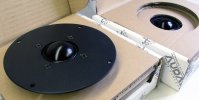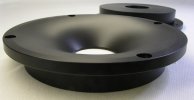Probably.Nor should you expect any output???
-
WANTED: Happy members who like to discuss audio and other topics related to our interest. Desire to learn and share knowledge of science required. There are many reviews of audio hardware and expert members to help answer your questions. Click here to have your audio equipment measured for free!
You are using an out of date browser. It may not display this or other websites correctly.
You should upgrade or use an alternative browser.
You should upgrade or use an alternative browser.
Single Capacitor Two Way Crossover -- distortion??
- Thread starter milezone
- Start date
Newbie question: If the response is so ragged why is adding a tweeter so wrong? In this case, the full range would effectively be used as a wide range, with a woofer doing duty for the bottom 2 octaves and a tweeter doing duty for the top 2 octaves.Yes, they are on-axis. But off axis response of fullrange drivers rarely drop off smoothly above 5kHz, so adding a (super)tweeter as low as 5kHz is wrong. See measured Mark Audio Alpair10P-A off-axis response on Rucho's Audio Page:
http://rutcho.com/speaker_drivers/alpair_10p_a/alpair_10p_a.html
View attachment 55536
Red = on axis, Blue = -15 deg, Green = -30 deg.
Even at -30 deg. off-axis, response is flat up to 7 kHz, than huge drop off the cliff, but then big peak at 15 kHz.
mhardy6647
Grand Contributor
- Joined
- Dec 12, 2019
- Messages
- 11,409
- Likes
- 24,768
Adding a "supertweeter" won't fix ragged.Newbie question: If the response is so ragged why is adding a tweeter so wrong? In this case, the full range would effectively be used as a wide range, with a woofer doing duty for the bottom 2 octaves and a tweeter doing duty for the top 2 octaves.
There are (have) been extended-range drivers with relatively smooth roll-off.
Such designs are out of fashion nowadays.
A woofer like this one can be augmented with a treble driver (not a supertweeter per se, though) using a first order XO (with, or without a first order XO on the woofer).
These are a tad pricey though, new or used.

Altec 515B (this particular one is a vintage example)
There are a surprising number of full-range drivers for sale. The best are hundreds of dollars. Then you get to worry about the limited bass extension as well as the ragged high end and beaming. And, the cone motion at bass intermods the highs. You do avoid a crossover though, and if you listen at very low volumes maybe you;ll be happy.
Vladimir Filevski
Addicted to Fun and Learning
- Joined
- Mar 22, 2020
- Messages
- 568
- Likes
- 760
The whole idea of the OP (to add a supertweeter above 20 kHz) is wrong, because majority of fullranges have big issues in the high range below 20 kHz! Adding a (super)tweeter with 6 dB/octave filter (single capacitor) is wrong for any tupe of loudspeaker (including single fullrange drivers, 2-way, 3-way...), even at 20 kHz crossover frequency, because it will produce comb-effect problems below 20 kHz.
Last edited:
If I said this before, I apologize, but using a first-order crossover on a device with a resonance below the intended crossover point can lead to a variety of bad things happening, because the cone displacement is still rising (not constant) below the intended crossover point, and may (thanks to the complex impedance of the driver) peak massively at the driver's resonance.
I don't think anything lower than second-order is really acceptable.
I don't think anything lower than second-order is really acceptable.
I was referring to a tweeter that covered the top 2 octaves (say 5k to 20k). Several tweeters (including ribbons and small domes) operate nicely above 5kHz.Adding a "supertweeter" won't fix ragged.
There are (have) been extended-range drivers with relatively smooth roll-off.
Such designs are out of fashion nowadays.
True. A full range used with a woofer (for the bass) and a tweeter (for the highs) would be more of a wide range covering maybe 150hz to 6kHz. Of course, one could then consider a mid-range that is explicitly designed to handle 150-6k with room at either end to allow for a transition to the woofer/tweeter. I don't know of any midrange (maybe the B&G Neo 10) that can do this.There are a surprising number of full-range drivers for sale. The best are hundreds of dollars. Then you get to worry about the limited bass extension as well as the ragged high end and beaming. And, the cone motion at bass intermods the highs. You do avoid a crossover though, and if you listen at very low volumes maybe you;ll be happy.
It's kinda futile to extend the range beyond 20k. Most of us can't hear beyond 16k anyway. For the few that can, a tweeter that covers 5k to 30k (Fs below 2500Hz) should suffice.The whole idea of the OP (to add a supertweeter above 20 kHz) is wrong,
For the HF section of a crossover, this makes sense. To extend the LF of a full range below, say 150hz, 6db/octave can work.I don't think anything lower than second-order is really acceptable.
mhardy6647
Grand Contributor
- Joined
- Dec 12, 2019
- Messages
- 11,409
- Likes
- 24,768
Oh, yah*, I know...I was referring to a tweeter that covered the top 2 octaves (say 5k to 20k). Several tweeters (including ribbons and small domes) operate nicely above 5kHz.
Such a driver'll help with rolled off, but not so much with ragged.



__________________
* Imagine these two words in a lilting, Garrison Keillor-esque Norwegian bachelor farmer voice.
Center Photo :
That is a Jvc Hsw1101-01a ribbon tweeter, I have used them and they are excellent. By the way, oddly enough, JVC made and sold them in the OEM market, but didn't use them in their commercial cabinets.
Doesn't it make sense to cross a two-way with a capacitor at .......20 KHZ?
They have already explained the pros (none) and cons (all)
That is a Jvc Hsw1101-01a ribbon tweeter, I have used them and they are excellent. By the way, oddly enough, JVC made and sold them in the OEM market, but didn't use them in their commercial cabinets.
Doesn't it make sense to cross a two-way with a capacitor at .......20 KHZ?
They have already explained the pros (none) and cons (all)
mhardy6647
Grand Contributor
- Joined
- Dec 12, 2019
- Messages
- 11,409
- Likes
- 24,768
Negative.Center Photo :
That is a Jvc Hsw1101-01a ribbon tweeter, I have used them and they are excellent. By the way, oddly enough, JVC made and sold them in the OEM market, but didn't use them in their commercial cabinets.
Doesn't it make sense to cross a two-way with a capacitor at .......20 KHZ?
They have already explained the pros (none) and cons (all)
It is the Radio Shack knockoff thereof (cat. no. 40-1375) not the actual JVC leaf tweeter (which was quite good).
The R/S knockoff is pretty good, too, albeit quite plastic-y.

R/S used a nicer leaf tweeter morph in one of their loudspeaker systems that was much more nicely made and may have been JVC OEM, though.
I only ever had one of them, so I ultimately gave it to someone who needed one.


Doesn't it make sense? (to quote the poster above)
Sure. Nominal 20 kHz XO = -6 dB at 10 kHz
Can be appropriate for a supertweeter depending on its sensitivity and the driver or system to which it is being coupled.
No obvious cons to me.
I am really not sure what you're getting at.
Negative.
It is the Radio Shack knockoff thereof (cat. no. 40-1375) not the actual JVC leaf tweeter (which was quite good).
The R/S knockoff is pretty good, too, albeit quite plastic-y.

R/S used a nicer leaf tweeter morph in one of their loudspeaker systems that was much more nicely made and may have been JVC OEM, though.
I only ever had one of them, so I ultimately gave it to someone who needed one.


Doesn't it make sense? (to quote the poster above)
Sure. Nominal 20 kHz XO = -6 dB at 10 kHz
Can be appropriate for a supertweeter depending on its sensitivity and the driver or system to which it is being coupled.
No obvious cons to me.
I am really not sure what you're getting at.
Looks almost but not quite like a beston ribbon. The beston ribbons are quite decent.
It looks a lot like him. The JVC originals were excellent, can't comment on RS.Negative.
It is the Radio Shack knockoff thereof (cat. no. 40-1375) not the actual JVC leaf tweeter (which was quite good).
The R/S knockoff is pretty good, too, albeit quite plastic-y.

R/S used a nicer leaf tweeter morph in one of their loudspeaker systems that was much more nicely made and may have been JVC OEM, though.
I only ever had one of them, so I ultimately gave it to someone who needed one.


Doesn't it make sense? (to quote the poster above)
Sure. Nominal 20 kHz XO = -6 dB at 10 kHz
Can be appropriate for a supertweeter depending on its sensitivity and the driver or system to which it is being coupled.
No obvious cons to me.
I am really not sure what you're getting at.
You can cross it as you want, it is your project.
mhardy6647
Grand Contributor
- Joined
- Dec 12, 2019
- Messages
- 11,409
- Likes
- 24,768
Much, much older.Looks almost but not quite like a beston ribbon. The beston ribbons are quite decent.
"New for '84"
Not a ribbon per se. More like a Magneplanar-style planar driver.
Very sweet sounding, extended, smooth, and fairly sensitive.
source: https://www.radioshackcatalogs.com/flipbook/1984_radioshack_catalog.html
No matter the make or model, they are all very poor at vertical dispersion. Make sure you don't get up from your seat. I used the JVC a long time ago, today I enjoy the Audax TW034X0, added to the Troels waveguide. I walk around the room and there are no significant off-axis differences.....
Attachments
Similar threads
- Replies
- 9
- Views
- 3K


